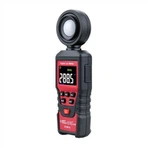Range Selection for Each Gear of Multimeter and Measurement Error Analysis
The selection of range for each gear of a multimeter and the analysis of measurement errors may result in certain errors when measuring with a multimeter. Some of these errors are the maximum absolute errors allowed by the accuracy level of the instrument itself. Some are human errors caused by improper adjustment and use. By correctly understanding the characteristics of a multimeter and the causes of measurement errors, mastering the correct measurement techniques and methods, measurement errors can be reduced
Human error in reading is one of the reasons that affect measurement accuracy. It is inevitable, but can be minimized as much as possible. Therefore, special attention should be paid to the following points during use: 1. Before measurement, the multimeter should be placed horizontally and mechanically zeroed; When reading, keep your eyes perpendicular to the pointer; When measuring resistance, zero should be adjusted every time the gear is changed. If it cannot be adjusted to zero, a new battery should be replaced; When measuring resistance or high voltage, do not hold the metal part of the probe with your hand to avoid human resistance shunt, increase measurement error or electric shock; When measuring the resistance in an RC circuit, it is necessary to cut off the power supply in the circuit, discharge the stored electricity in the capacitor, and then proceed with the measurement. After excluding human reading errors, we conducted some analysis on other errors
1. Selection and measurement error of voltage and current range for multimeter
The accuracy level of a multimeter is generally divided into several levels such as 0.1, 0.5, 1.5, 2.5, and 5. The calibration of accuracy (precision) levels for DC voltage, current, AC voltage, current, and other gears is expressed as the percentage of the maximum absolute allowable error △ X to the selected full-scale value of the range. Expressed in formula: A%=(△ X/full-scale value) × 100%... 1
(1) Using multimeters with different accuracies to measure the error generated by the same voltage
For example, if there is a 10V standard voltage and two multimeters with 100V gear, 0.5 level and 15V gear, and 2.5 level are used for measurement, which one has the smallest measurement error?
Solution: From equation 1: The first measurement: Maximum absolute allowable error
△X1=±0.5%×100V=±0.50V.
Second measurement: maximum absolute allowable error
△X2=±2.5%×l5V=±0.375V.
Comparing △ X1 and △ X2, it can be seen that although the accuracy of the first meter is higher than that of the second meter, the error generated by measuring with the first meter is larger than that generated by measuring with the second meter. Therefore, it can be seen that when choosing a multimeter, higher accuracy is not necessarily better. With a highly accurate multimeter, it is also necessary to choose a suitable range. Only by selecting the correct range can the potential accuracy of a multimeter be fully utilized






